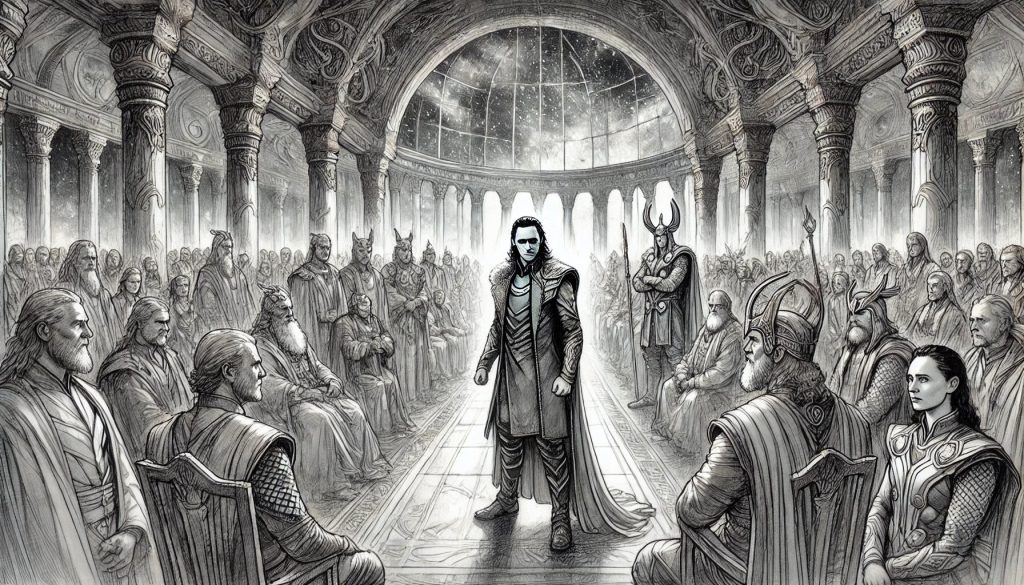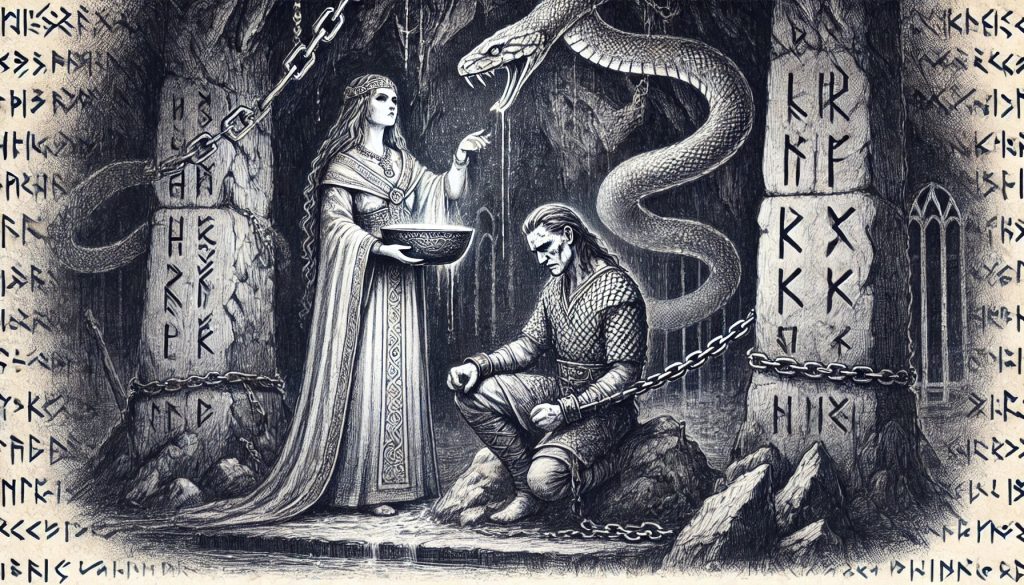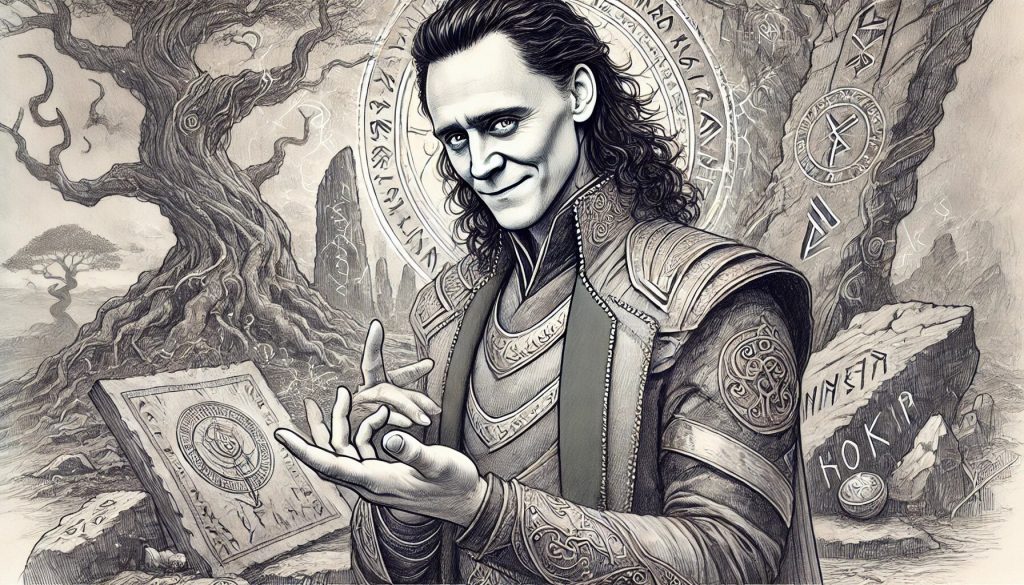Aesir Gods, Baldur, Giants (Jötunn), Loki, Norse Gods, Norse Mythology, Odin, Tales of the Gods, Thor
The Punishment Of Loki
In Norse mythology, Loki is known for his cunning and mischief. He was the trickster of the gods, bringing laughter and chaos to Asgard. But his tricks led to his downfall and punishment by the gods. This story tells of Loki’s punishment and the dramatic events that followed in Norse lore.
Join us as we explore Loki’s journey of deceit, sorrow, and atonement. We’ll follow the twists and turns of this ancient myth. It shows how Loki was bound to his fate and the lessons we can learn from it.
Let’s explore Norse mythology and Loki’s lasting punishment. We’ll explore the world of gods and giants and see how Loki’s actions affected the world of men.
Introduction to Loki’s Punishment
In Norse mythology, Loki is a fascinating and complex character. He is punished eternally for his mischievous actions and for betraying the gods. Before we dive into his punishment, let’s explore his origins and the events that led to his fate.
The Origins of Loki
Loki, known as the Trickster God, was born in Jötunheimr, the realm of the Giants. He doesn’t share the divine heritage of the Asgard gods. His parents, Farbauti, a giant, and Laufey, a lesser-known figure, make him both a god and a giant, an oddity in the realms.
Being an outsider, Loki often found himself caught between his giant kin and the gods. His cunning and shape-shifting skills made him key in many adventures. Yet, his true motives were often unclear.
Loki’s complex relationships with his family and the gods show his complex nature. He is Odin’s blood brother and Thor’s adoptive brother. But, his family ties didn’t save him from the consequences of his actions.
Loki’s actions in Norse mythology led to chaos and tragedy for both gods and mortals. His mischief caused irreversible harm. As the story goes, Loki’s choices end in his punishment, a fitting end for a complex character.
Loki’s Crimes
Loki, the Norse god of mischief, is known for his clever tricks and deceit. His actions have changed the course of events in Asgard and Midgard, deeply affecting both gods and mortals.
The Mischief-Maker
Loki’s tricks often caused chaos and disaster. He caused the death of Baldr, a beloved god, and set the stage for Ragnarok. His actions led to wars and strained relationships, testing the existence of the realms.
One of Loki’s worst acts was stealing Idunn’s golden apples. These apples kept the gods, such as Odin and Baldr, young forever. Without them, the gods faced aging and weakness.
Loki also contributed to the death of Thjazi, a frost giant, which led to his own punishment. The gods, upset by his betrayal, put him on trial and arrested him.
Loki’s stories in the Norse sagas show his cunning and unpredictability. He used shape-shifting and clever words to trick others. His skills in trickery are unmatched, making even Odin and Thor wary.
Loki’s actions teach us about the dangers of mischief and deceit. They remind us to think about how our actions affect others. We must be accountable for our actions.
The Gods’ Judgment
The Trial of Loki
Loki’s crimes against the gods of Asgard grew worse. The Norse gods’ council decided it was time to judge him. They held a trial to figure out what punishment Loki should get.

The trial was very serious. The gods, including Odin and Thor, came together to listen to both sides of the story. They would decide Loki’s fate, giving him a punishment that fit his crimes.
The trial, attended by gods like Odin and Thor, was filled with strong speeches and debates. The prosecution showed how Loki caused trouble. The defense asked for mercy, saying Loki acted out of jealousy and a wish to be accepted. However, the fact that Loki caused the death of Baldr made it hard to forgive him.
During the trial, the gods felt many emotions. Some wanted justice and a harsh punishment. Others thought Loki could change and wanted a lighter sentence. This trial tested the gods’ relationships, weakening some friendships, such as those involving Thor and Baldr.
After much consideration, the gods made their decision. Not all agreed on what to do with Loki. Some wanted him locked up forever, while others thought he could change with a lighter punishment.
The gods’ decision on Loki showed their complex nature. It showed how hard it is for gods to balance justice, mercy, and consequences. This trial made the gods think about their choices and how they affect the world and people.
Loki’s Capture
After the trial, the gods set out to catch Loki. They wanted to punish him for his wrongdoings. This chase took them across many realms and dimensions.
The Chase and Capture
Catching Loki was a big challenge. He was known for being very clever and tricky. The gods had to plan carefully to catch him.
Loki tried to get away, using all his tricks. But the gods were not easily fooled. They kept chasing him, showing they were serious about justice.
Loki changed into an animal, even a salmon, and looked like an ordinary thing to try to escape, particularly after causing Baldr’s death. But the gods were clever, too. They overcame all his tricks and caught him.
After many battles and clever moves, the gods finally caught Loki. This showed their strong commitment to order and justice, essential to prevent ragnarök.
Loki’s capture was a big moment. It showed justice winning over chaos. It proved the gods’ power and authority, especially figures like Odin and Thor, who sought justice for Baldr’s death.
- The chase and capture of Loki showed the gods’ determination to bring him to justice.
- Loki’s escape attempts tested the gods’ resolve and ingenuity.
- The gods’ pursuit of Loki demonstrated their unwavering commitment to maintaining order.
- After a series of battles and clever maneuvers, the gods successfully captured Loki.
The Binding of Loki
Once caught, Loki gets the worst punishment. The gods bind him to stop his tricks. But, he doesn’t know his punishment will also hurt a lot.
The Shackling of Loki
The gods try to keep Loki locked up with special chains. They make these chains from unique materials. This way, Loki can’t escape.
These chains are magical and enchanted by the gods. They’re made to keep Loki powerless and stuck. Each chain link is strong enough to stop Loki’s strength and cleverness.
Loki’s body is wrapped in chains, stopping him from moving or using his powers. This makes him feel trapped, and his mind suffers too. He realizes he can’t escape and is truly powerless.
Every time Loki tries to break free, it hurts a lot. The chains remind him of his wrongdoings and his punishment. This shows the gods and mortals the cost of his bad actions.
Loki is filled with sorrow and pain in his prison. But this keeps him from causing trouble. The gods’ act shows their dedication to keeping peace and justice. It protects everyone in the nine realms.
Sigyn’s Vigil
Sigyn’s Loyalty
When Loki faced punishment, his wife Sigyn showed true devotion and loyalty. She stood by him, even through hard times and sacrifices, which sometimes led to using entrails.
Sigyn didn’t just accept her role quietly. She actively supported Loki, holding a basin to catch the venom from a serpent. This act showed her deep love and sacrifice for her husband.

Sigyn was always there for Loki, offering comfort during his hard times. Her commitment to protecting him showed her deep love and loyalty.
Sigyn’s vigil became a symbol of strength and sacrifice. Her loyalty showed the true power of love, and she proved that love can push us to do great things for those we care about.
Today, Sigyn’s story still moves us. It shows the strength of love and loyalty. Her commitment to Loki during his punishment shows the impact loyalty can have, even in tough times.
The Serpent’s Venom
The Venomous Torture
Loki’s punishment takes a deadly turn, with the venom of a serpent dripping from a snake’s mouth. The gods use a serpent with venom as deadly as Loki’s betrayal. The serpent hangs above him, ready to spit its toxic liquid on Loki’s face.
The venom is more than just physical pain for Loki. It symbolizes the harm he caused. With each drip, his pain grows, making his suffering worse.
This torture reminds Loki of his wrongdoings and the pain he caused others, particularly when he caused Baldr’s death. It’s a way for him to pay for his part in Asgard’s chaos. Every painful moment makes him think about his actions.
Loki’s torment shows us his deep regret and his chance for redemption. The venom pushes him to think deeply about his choices, making him decide whether to keep being evil or try to change.
Impact on Earth
The Consequences for Midgard
Loki’s punishment in Norse mythology affects more than just Asgard. It impacts Midgard, the world of humans. His tricks and lies have deeply influenced the human world.
Loki’s actions have caused chaos and destruction on Earth. His stories tell of stirring trouble among the gods and causing Baldr’s death, which shows his big impact on Earth, especially after Loki caused Baldr’s death.
Midgard, where humans live, feels Loki’s punishment the most. His evil actions disturb the gods and the natural world, contributing to the events of ragnarök. This leads to disasters, wars, and suffering in Midgard because of Loki.
The effects on humans are serious. Loki’s actions go beyond just stories. They teach us about the big impact our actions can have. Loki’s story reminds us of how everything is connected and our role in keeping peace and order.
Cultural Reflections
The Enduring Legacy
Loki, the trickster god from Norse mythology, has made a lasting impact on our culture. His story has been retold many times, keeping us interested and engaged. We’ll look at how Loki’s legacy lives on in literature, art, and today’s media.
Loki’s influence stretches from ancient tales to today’s movies and TV shows. Writers, poets, and playwrights have celebrated him, showing how much we love this mysterious figure. Artists and sculptors have also captured his spirit, making him come alive in their work.
In today’s world, Loki is a favorite character, appearing in comics, movies, and more. Tom Hiddleston’s role in the Marvel Cinematic Universe has made him even more popular. Fans can’t wait to see him on screen, proving Loki’s lasting impact on culture.
Loki’s influence goes beyond just entertainment. His story makes us think about identity, rebellion, and power. As a complex character, he shows us the good and bad in ourselves. His choices make us question our own morals and values, just as Odin once questioned Loki.
Loki’s impact is seen everywhere, from merchandise to fans who connect with his story. People around the world find meaning in his tales and see themselves in his actions and outcomes.
Loki’s cultural impact is still growing, even after Baldr’s tragic death. His story continues to inspire and intrigue us, proving the power of myths in our modern lives. In popular culture, Loki shows how ancient stories like his binding in a cave can still touch and influence us today.
Lessons from the Myth
The myth of Loki’s punishment teaches us about redemption, the effects of our actions, and how we can change. Loki’s story shows us moral lessons that we can apply to our lives.
Themes of Redemption and Consequences
Loki’s story is full of redemption. Even after causing trouble, he changed and grew. This teaches us that we’re not stuck by our past. We can change and make things right.
Loki’s actions had big effects on the gods and the world. This shows how our choices can impact others. It tells us to think before we act, especially if we’re planning something mischievous.
The myth also stresses the importance of owning up to our mistakes, much like how Loki had to face the consequences of causing Baldr’s death. Loki’s punishment shows us the value of facing the results of our actions. Taking responsibility helps us grow and can lead to making things right.
In the end, Loki’s story gives us deep moral lessons. It makes us think about redemption and the outcomes of our actions. By learning from this old tale, we can better understand ourselves and the power of change.
Conclusion
Our journey through Loki’s punishment ends with a deep understanding of its consequences. The trickster Loki faced many trials for his wrongdoings against the gods.
This mythic tale teaches us that our actions have big effects, especially during Ragnarök. It shows how chasing our own desires can lead to our downfall. Loki’s story highlights the balance between good and evil and the value of remorse and redemption.
Loki’s actions affected not only the gods but also the mortal world of Midgard. The story warns us about the fragility of life and our relationships and shows the dangers of upsetting the universe’s balance.
As we say goodbye to this captivating story, let Loki’s punishment guide us in understanding the consequences when Loki caused the death of Baldr. Let it inspire us to make wise choices, seek redemption when needed, and understand the power of consequences. Loki’s story teaches us about the nature of good and evil.

